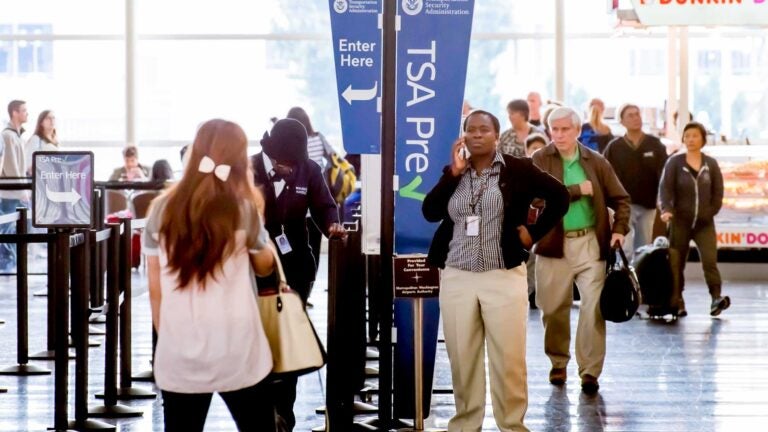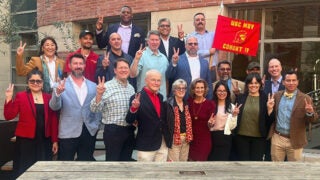
Expedited screenings carry a minimal risk to passenger safety, according to researchers. (Photo/iStock)
What airline passengers want most: to get through security quickly
The advantages of programs like TSA Precheck far outweigh feared drawbacks, new study finds
The Transportation Security Administration should consider expanding expedited screening measures like TSA Precheck for airline passengers, according to a new study in the journal Risk Analysis.
“A value-measure for public sector enterprise risk management: A TSA case study” was co-authored by a USC professor and one of the principal architects of the Transportation Security Administration’s screening system.
The researchers found that the strategy most effective at maximizing overall value to society was in fact increased expedited passenger screening programs where passengers pay a fee to go through a background check and obtain special clearance for the convenience of low-hassle security screenings. They also found that expedited screenings carry a minimal risk to passenger safety.
Using publicly available information from the TSA, the researchers modeled the drawbacks and benefits of six different types of security measures. Of the six strategies, expedited screening provided by far the greatest overall benefit.
It’s always possible that terrible things might happen, but there are all these potential benefits in the overwhelmingly likely event that they don’t.
Ali Abbas
“It’s always possible that terrible things might happen, but there are all these potential benefits in the overwhelmingly likely event that they don’t,” said Ali Abbas, director of the Neely Center for Ethical Leadership and Decision Making and USC professor of industrial and systems engineering at the USC Viterbi School of Engineering. Kenneth Fletcher, former chief risk officer of the TSA, was the co-author.
Presenting a clear value to passengers
The six strategies Abbas and Fletcher included in their comparison analyses were:
- Reducing expedited screening.
- Increasing vetting for travelers in this trusted class.
- Decreasing probability of all possible concealed items that could be used as a weapon.
- A hybrid of the second and third strategies.
- Increasing expedited screening.
- Increasing both vetting and expedited screening.
The researchers found that coupling increased vetting with this expedited screening could provide the most upside when factoring in the full range of potential attacks, though it would come at increased cost to the passenger.
While increasing expedited screening produces by far the best overall value for passengers, this strategy may prove unpalatable to security administrators, as any significant changes in screening would be heavily scrutinized in the wake of an attack.
“Any strategy can be criticized once a bad outcome happens, but that does not mean we should unduly focus only on potentially negative outcomes that are not likely to materialize. If you’re only judged by an outcome, rather than by the decision-making itself, then the system will never improve,” Abbas said.
For fiscal year 2015, the TSA directly spent about $3.2 billion to prevent terrorist attacks to commercial aviation.
Rethinking risk
In their study, Abbas and Fletcher state that much of the problem is due to the fundamental way federal agencies like the Department of Homeland Security and the Transportation Security Administration view risk.
“There are many challenges to government decision-making. First, several definitions of ‘risk’ adopted by government departments and agencies emphasize the negative consequences related to the mission. As an example, the U.S. Department of Homeland Security defines risk as ‘the potential for an unwanted outcome resulting from an incident, event or occurrence,’” they write. “This common perception of risk as a negative outcome needs to change toward an understanding of the whole distribution of outcomes and their consequences.”
Abbas added that, in any other arena, this type of “risk” is often the gateway to more novel solutions.
“Think by analogy to business enterprises. If you are concerned only about the possibility of exceeding your budget in a pharmaceutical company, you would never engage in new and promising opportunities that may lead to the cure for cancer or Alzheimer’s disease or any other innovation in science and technology,” he said.
Another factor to consider in administrative decision-making agencies like the TSA, according to Abbas, is the transitory nature of that decision-making. In the 16-year history of the TSA, it has had seven different administrators. The latest, David Pekoske, was sworn in on Aug. 10.
“There are challenges posed by government incentives. No TSA administrator has lasted more than three years. Are you going to invest in a product or technology that will outlast you by at least four years? This is a challenge across many types of government enterprises,” Abbas said. “Very short time horizons may incentivize poor decision-making. You need to rely on a sound decision process to justify investments that are more valuable to the American people on the long term.”



